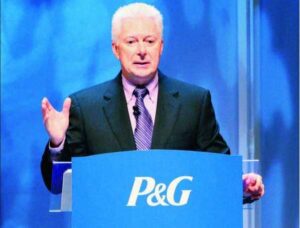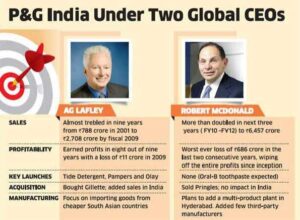It was a mistake to take HUL head on when we first entered India: AG Lafley, CEO, P&G

AG Lafley, who last week returned as the CEO of Procter & Gamble after a gap of four years, feels it was a mistake to take big rivals such as Hindustan Unilever head on when P&G first entered India. It would have been much easier to build a beachhead in the market if it had first attacked segments where big rivals were not present in, such as baby care and skin care, he told Kamini Banga in an interview. Edited excerpts:
On P&G’s strategy in picking the markets it would operate in.
I see a lot of companies and industries and it is amazing how many of them fall into one of two traps; they attack their strongest competitor first or they attack their competitors all at once and that is a recipe for disaster. It is the Don Quixote strategy for attacking walled cities. Let me explain – there was a lot of talk in the late 1990s and 2000 about emerging markets, BRICs in particular.We chose markets that were not all BRIC markets – China, Russia, Eastern Europe, Mexico and Turkey.
We believed that Brazil and India were walled cities, being Unilever and Nestle strongholds. Our view was that we could take a decade to improve our position in India and Brazil. The other big strategy trap is the failure to make choices. It is true that leaders and managers do not like to make choices because it is riskier both from the business and a personal standpoint.

On strategy for emerging markets:
I don’t think it is different conceptually – you need to make the same five choices. I always smile when someone tells me that they have an emerging market strategy. I don’t think we or Unilever ever had an emerging market strategy, there was a strategy for India, for Indonesia, for Brazil. Every market, every consumer segment requires a winning strategy. On picking the wrong strategies for the company in India and Brazil: Our first business in India in the mid 80’s was small and came with the acquisition of Vicks.
We attacked in categories like bar soaps and laundry where Unilever and local brands like Nirma and Godrej were strong. We did much better where we attacked in categories in which they did not operate such as feminine care, baby care, hair care business and skin care.
We made huge mistakes in Brazil by attacking several of our competitors head on; Unilever in laundry, Kimberly Clark in baby diapers and it wasn’t until we built big beauty care and health care businesses and it wasn’t until we acquired Gillette that we had a position we needed in Brazil. I guess in military terms, it was easier to establish a beachhead if we weren’t competing head on with the incumbent. And the other thing which was very real for us in our market our business is very dependent on brand and talent, brand innovation and talent.
And Unilever in the 1980s and 1990s could hire the best Indian talent. We had to find really good Indian managers. It wasn’t until we were there for a decade or two that we began to hire some really good people out of universities, and we did acquire some good people with Richardson-Vicks and Gillette and other acquisitions. But it is very hard when you haven’t been there for 100 years and you don’t have the reputation of Hindustan Lever to hire the best people. They take more of a chance to come with you. You are like
a start up.
On FIT, a failed product launch that lost P&G at least $50 million and that still frustrates him:
We had invented an all natural organic product for cleaning and washing fruits and vegetables, available in soak and spray form. At that time there was a growing concern around the world that there was not enough fruit and vegetables in our diets.
However, there were problems with sanitisation and hygiene with an outbreak of a fruit or vegetable related illness almost every year. So, we had an unmet concern, we had a unique product and we had a good brand name – FIT. Despite test marketing the brand four times, we could not create a worthwhile business.
Was it a failure of strategy or execution? In the final analysis it has to be the former because we could not change consumer habits, nor could we get any of the retailers to put FIT on the shelf with the produce because they did not want to suggest to shoppers that their produce was not perfectly clean. We had these two barriers and we could not overcome those.
On the global vs local debate:
Most of our consumers shop locally and live locally. The P&G of the 70s, 80s and the first half of 90s was trying to push its global brands and products on the rest of the world. We made a lot of mistakes and we had a lot of failures. In the late 90s and the last decade, we tried much harder to formulate the products to needs, desires and affordability of the local customer, and then we would decide – sometimes it would be local, and sometimes global.
Some of our global brands were really hybrids; we sold Rejoice shampoo in 30 markets across the world, but in China it has a very Chinese name under the Rejoice brand name and the Chinese consumer knows it by its Chinese name. Ariel in the Middle East has a local name in Arabic.
We got a lot smarter by striking this balance between local and global, and if you think about Indian companies taking their brands and products around the world or Chinese companies or Korean companies or Japanese companies, they have to make very sure that the product and brand appeals to the local consumer.
